“Braveheart” is a 1995 film directed by Mel Gibson, who also plays the lead role of William Wallace. Wallace is a historical Scottish figure who led a revolt against English tyranny after an English officer kills his bride. Filled with fierce battle cries, epic cinematography, and an outstanding performance from Gibson, “Braveheart” is a modern classic that has become a favorite for many viewers. The making of the film featured almost as many battles as the actual story and offers some interesting trivia.
Horses play a large role in the battle scenes as the better-equipped English forces attempt to ride down the Scottish rabble. In the story, Wallace has foreseen this problem and prepared his own troops with deadly pikes. Just as the English reach striking distance, Wallace’s line of men lift up heavy, rough-hewn timbers that have been carved into sharp points at the end. In a gruesome scene, the horses plunge into the points and are maimed or killed. To film the scene without injuring animals, filmmakers had mechanical horses built. The machines weighed 200 pounds and were placed on tracks. Nitrogen cylinders allowed the horses to be propelled at speeds up to 30 miles per hour. The effect was so believable, an animal rights organization investigated Gibson and didn’t believe the horses were fake until they were showed unedited footage. Gibson supposedly offered a token reward to anyone who could point out the fake horses in the final movie footage and never had to pay out.
“Braveheart” includes some of the most memorable battle scenes in modern movies, and filmmakers worked hard to keep the scenes as accurate as possible. In order to ensure everything was perfect, they took six weeks to film the battle of Stirling. Over 90 hours of film was shot and then edited into the few minute scene. Gibson even re-shot scenes from several battles because filmmakers noticed in editing that extras in the scenes were wearing sunglasses or watches.
The screenplay for “Braveheart” was written by Randall Wallace, who is a descendant of William Wallace. Randall Wallace did a lot of research in order to write a historically accurate story, but he was limited when it came to source material. He looked to sources like Churchill’s “A History of the English Speaking Peoples,” but even Churchill could find little solid material about William Wallace. In the end, Randall Wallace based much of the story on a 15th century poem by Henry the Minstrel.
As with any Hollywood depiction, the film does take some liberties with history. Although Randall Wallace had to use his imagination to fill in parts of William Wallace’s life, there are events and items in the film that are historically impossible. For instance, Wallace and his men use blue body paint to dress for battle, but historical evidence indicates warriors stopped using the paint over 800 years before the events in the film. Princess Isabella, who has several interactions with Wallace during the latter part of the film, was not in England until 1308, which is after the events of the story. Gibson also made the directorial decision to film the Battle of Stirling Bridge on an open plain because he felt a river setting would have detracted from the movie. Gibson admitted in several interviews that much of the story was fictitious and additions were made for dramatic narrative purposes.
“Braveheart” is based on a Scottish hero, a Scottish fight, and takes place on Scottish land. However, there is much about the film itself that is Irish. The battle scenes are filled with Irish extras. In fact, most of the extras are members of the Irish reserve army. According to anecdotes about the filming, the men were pulled from different companies that have ongoing rivalries. During the battle scenes, the men actually came to blows, which may have contributed to the realistic nature of those scenes. In addition to a plethora of Irish extras, the film also features a soundtrack that uses Irish pipes in places of Scottish Highland bagpipes.
“Braveheart” is a very interesting movie with some great stories surrounding it. With such an epic story to tell, it is not surprising that there are so many anecdotes and interesting facts associated with the making of the film. Perhaps more surprising than anything else is the fact that Mel Gibson did not want to star in the film. He felt that he was too old to play the character of William Wallace, and only agreed to the role because Paramount demanded that he do so.





